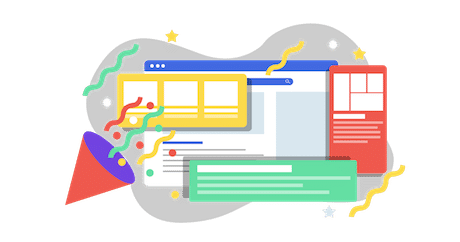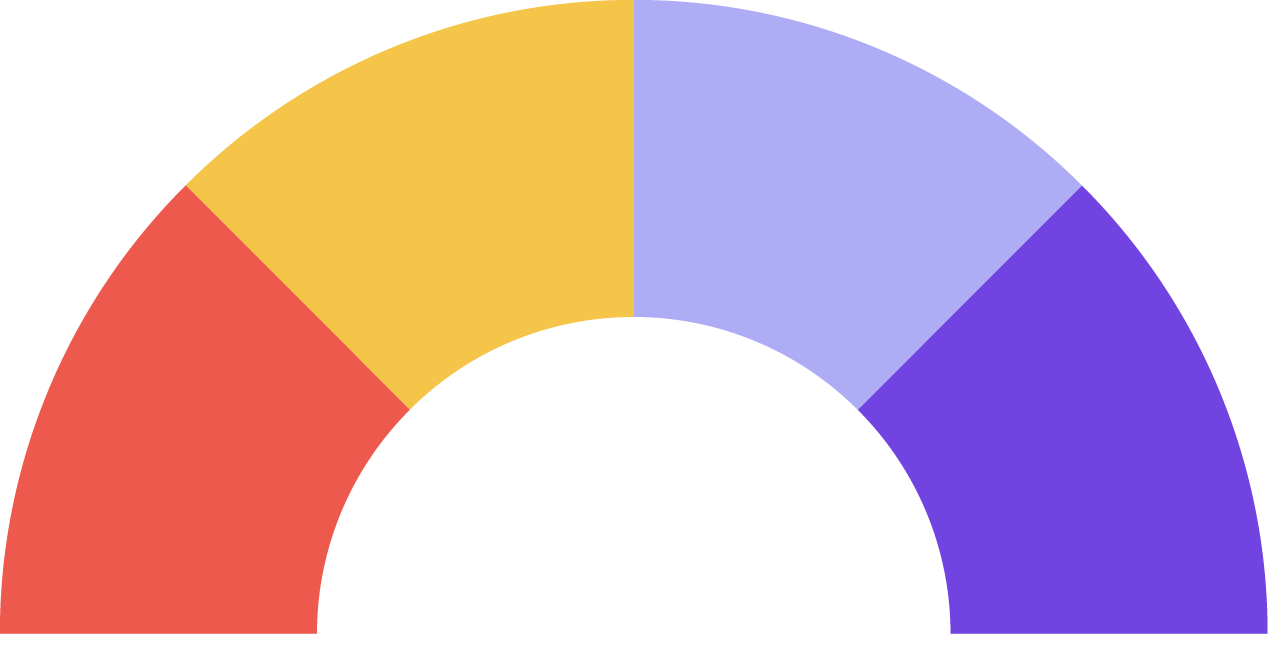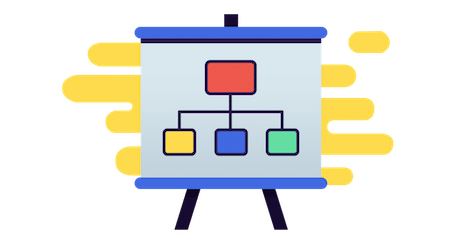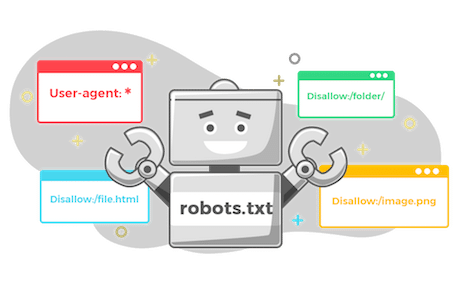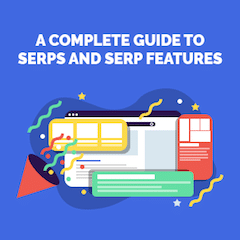 This is the complete guide to search engine results pages and SERP features.
This is the complete guide to search engine results pages and SERP features.
It contains everything you need to know about SERPs, from what they are, to how they’ve developed over the years.
Plus, how you can optimize for SERPs and an absolute list of today’s most important search engine results page features.
I’m covering:
- What are SERPs?
- Why SERPs Are Important for SEO
- A Brief History of Google SERPs
- How to Get Shown in the SERPs
- A Comprehensive List of Search Features
And much more.
Whether you are brand new to search engine optimization or a seasoned expert, there’s something for you in today’s guide.
Let’s dive right in.
DOWNLOAD: A free checklist that will show you step-by-step how to how to quickly and easily implement nine SEO fundamentals to improve your visibility in SERPs.
What Are SERPs?
The term “SERP” stands for Search Engine Results Page.
When you search on Google and other search engines, the SERP is what you get shown.
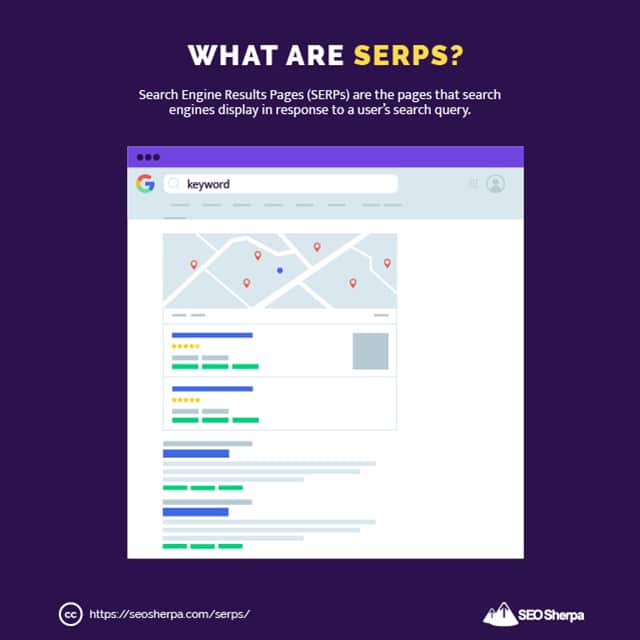
Search Engine Results Pages consist of two primary result types; paid search results and free organic search results:
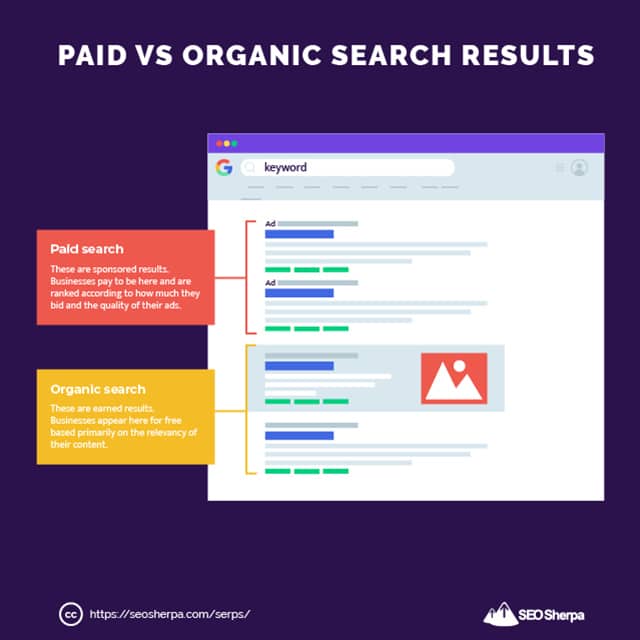
Beyond that, SERPs can include various features such as search ads, shopping ads, featured snippets, knowledge graphs, video, and image results. No two results are ever the same.
Each SERP is customized based on the individual user, the intent of their search query, and hundreds and hundreds of ranking factors. This means that users will rarely (if ever) see the exact same results – even when using the same search query and search engine.
Why SERPs Are Important for SEO
There is no search engine optimization (at least as we know it now) without SERPs.
That’s because the primary goal of SEO is to rank high on as many relevant SERPs as possible.
And not just high up in search result pages, ideally the number one spot – or no less than the first three:
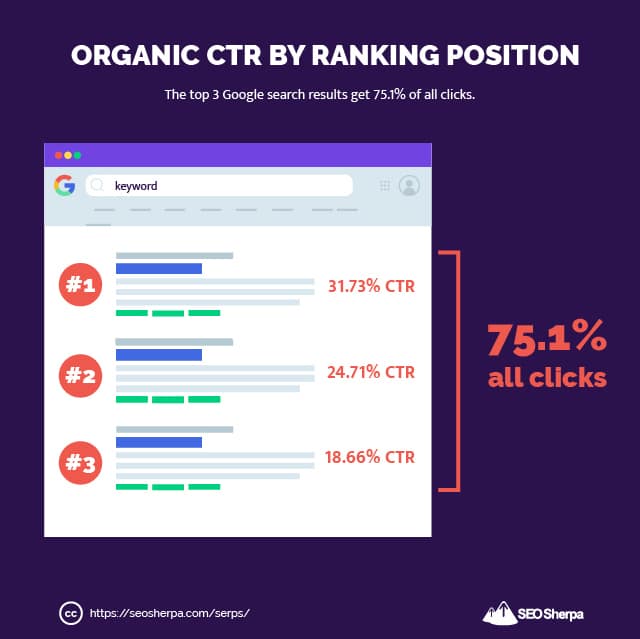
As you can see above, the lion’s share of traffic goes to the top-ranked results in the SERP.
And very few Google searches visit the second search engine results page.
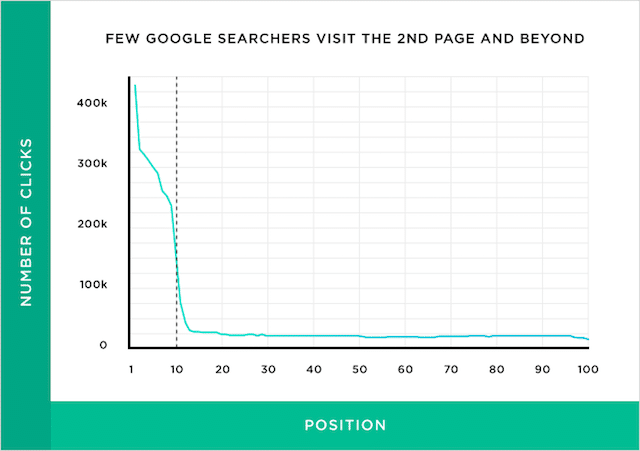
This means if you rank on page two or beyond, very few people are ever going to find you.
Still, don’t get fooled into thinking that merely ranking in the top spots on Google guarantees you a boatload of traffic for free.
Firstly, paid search results often push the organic search listings way down the page.
In fact, many commercial searches don’t show any organic results above the fold – not one:
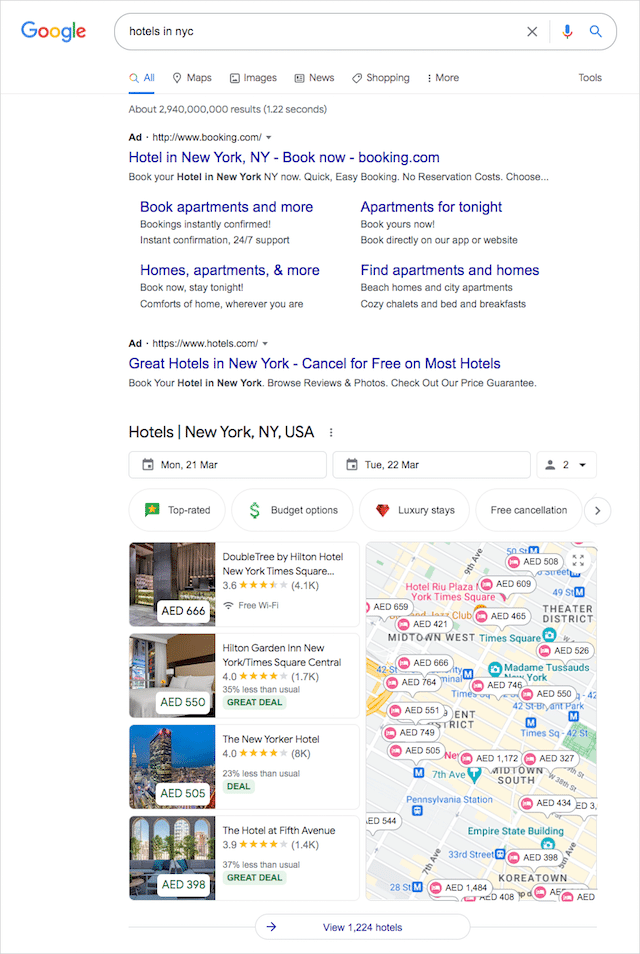
You could be the number one organic result for terms like the one above and still get little to no traffic.
Secondly, a lot of queries do not lead to a click.
Take the search term “404 error page” for instance:
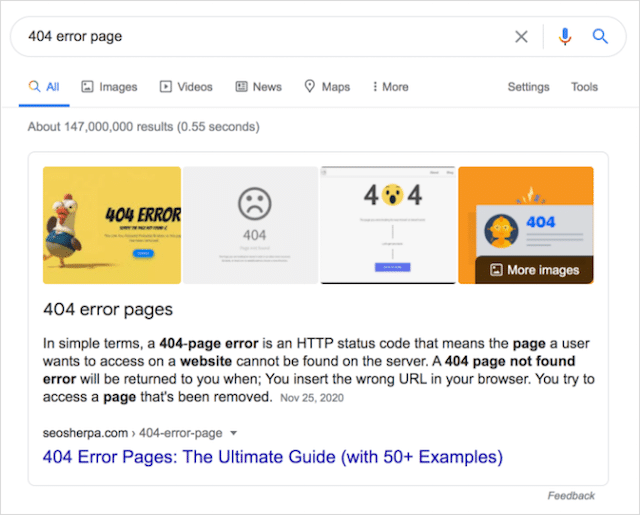
Google provides an instant answer to this query, meaning there’s no need for a user to click on any of the results they find on the page.
According to research by Sparktoro, there are more “zero-click” searches than ever before.
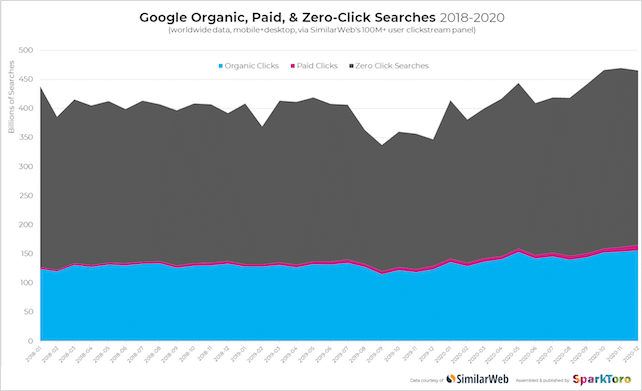
Responsible for this trend is the rise of featured snippets like answer boxes and paragraph snippets that answer the query from within the SERP.
If your goal is more organic traffic (who isn’t?), you want to target keywords that don’t have a lot of SERP features.
That way, your result is more likely to be seen and clicked on.
Google’s Search Engine Results Page: A Brief Visual History
Google has come a long way since it launched as “Backrub” out of a Stanford dorm room in 1996:
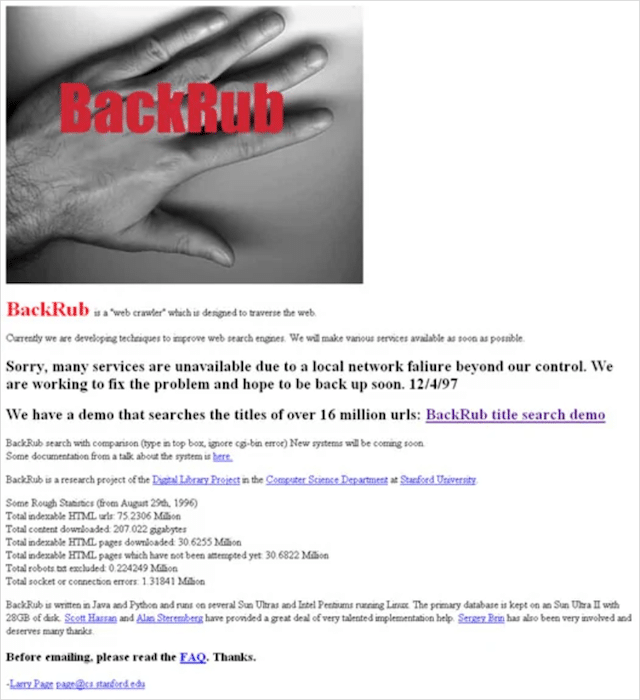
Today’s SERPs include a multitude of features that weren’t part of Google’s early search engine; ads, the knowledge graph, images, video, Google suggest… the list goes on.
But yet, other elements remain by and large the same.
Take for instance the standard number of results displayed on each search engine results page, it’s been ten ever since the first-named version of Google in 1997:
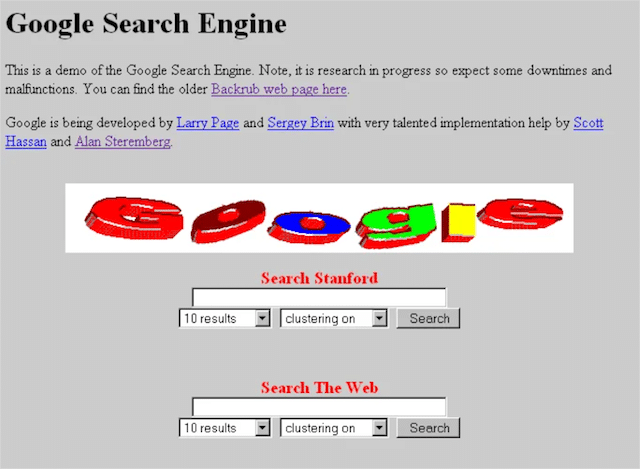
Or, Google’s customary simple search page is almost identical today as it was in 1999:
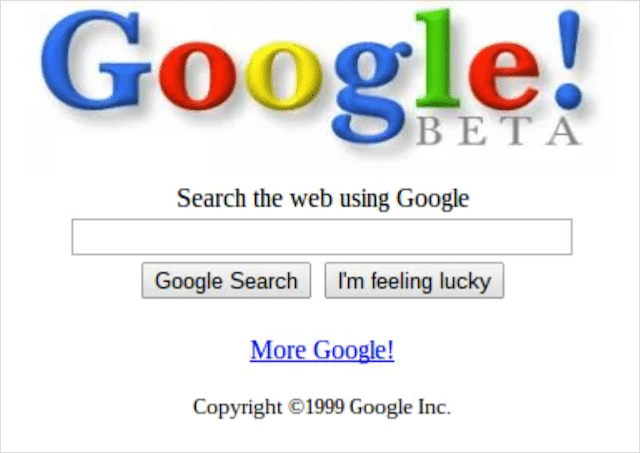
Other elements were introduced progressively over the years.
Here is a rundown of some of the biggest Google features to get launched over the past two decades.
Google Ads Launched (2000)
Initially, resistant to the idea of ads on their platform, Google launched their advertising product named Adwords in the year 2000.
Unlike other search engine ads at the time, Google’s ads were contextual and relevant to the user.
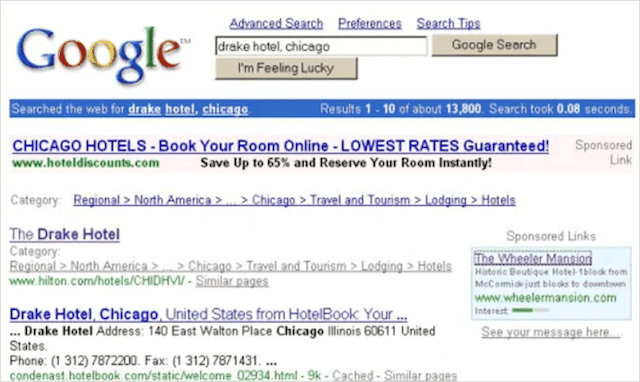
Google tested multiple layouts in the early years, all of which identified ads as “sponsored links” and set them apart from organic listings.
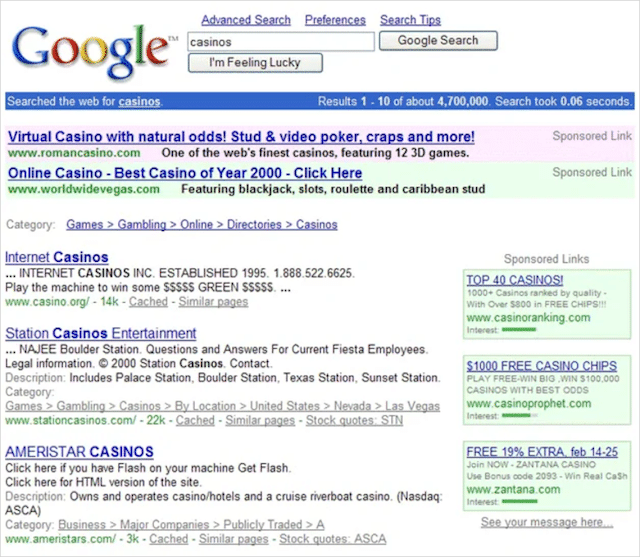
Vertical Search Launched (2001)
In its effort to organize all the world’s information regardless of type, in 2001 Google added vertical search capability.
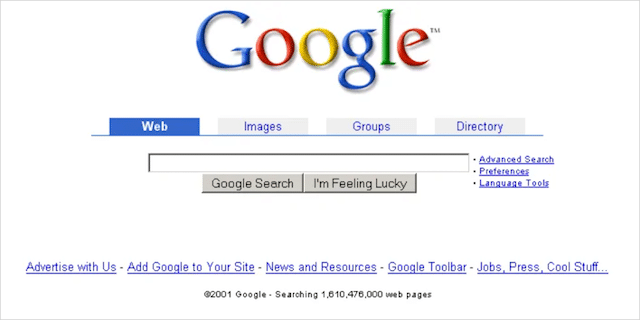
The initial view had four tabs; web, images, groups, and directory which showcased Google’s ability to search the web in multiple ways.
Universal Search Launched (2007)
To counter its vertical growth, Google added universal search in 2007.
Universal search combined the many separate components of the Google search experience into the main search engine results page.
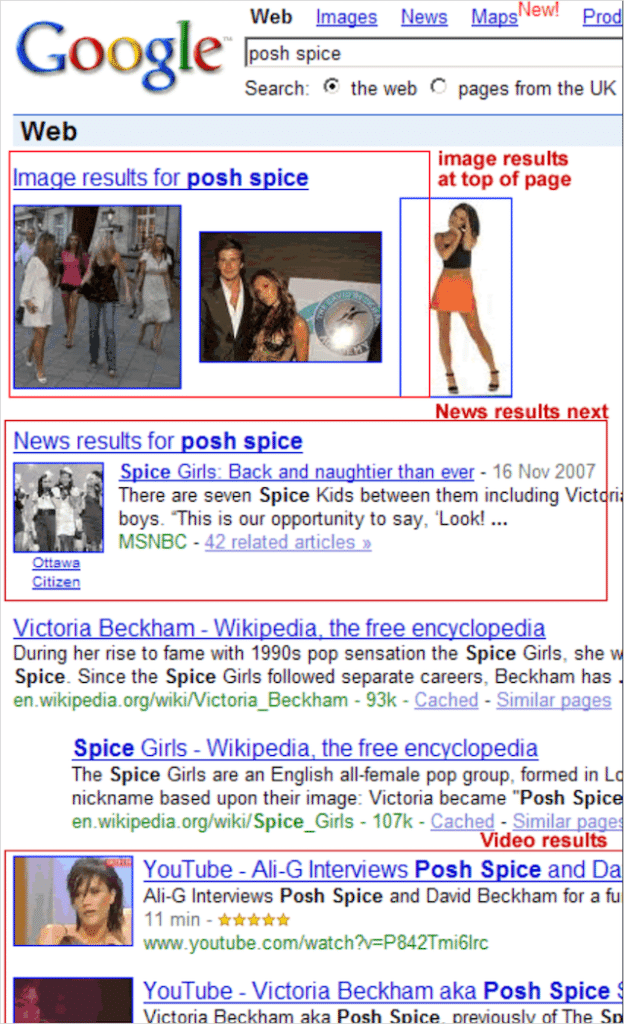
With this advancement, different sorts of results like images, videos, news, books, and patents could populate for any given search, meaning users wouldn’t have to perform separate searches in each verticle.
Google Suggest Launched (2008)
Google Suggest provides suggestions to users as they type a query into the search box.
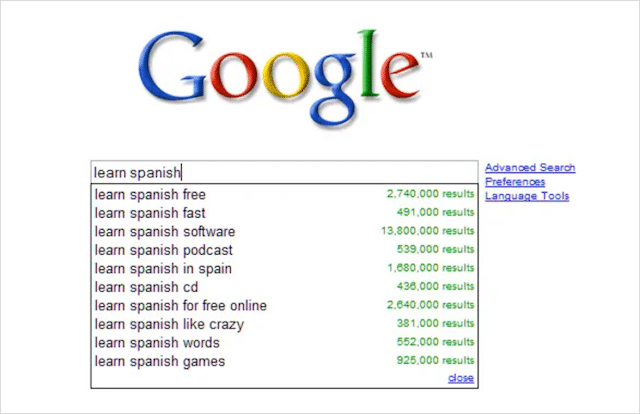
To determine what suggestions to show, Google’s systems look for common queries that match the phrase that someone starts to enter into the search box.
Autocomplete predictions reflect common searches that have been done on Google.
Pro Tip – You can use Google Suggest for keyword research to determine current trending keywords in your market. Enter a seed keyword into Google’s search box and see the suggestions that are presented.
Sidebar (2010)
In 2010, Google moved the links to its search result verticals to the left side of the page.
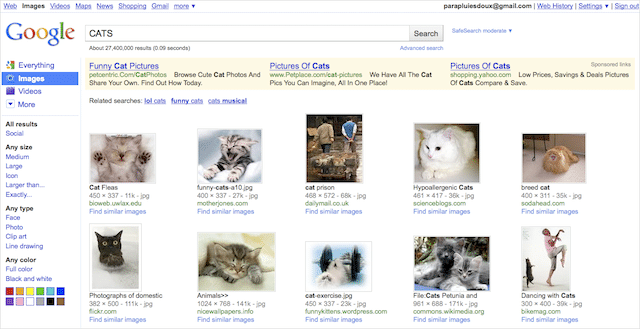
The move of its navigation to the lefthand side intended to make use of additional space created due to the widening of computer screens over time.
The sidebar was later abandoned.
Knowledge Graph Launched (2012)
Google added the Knowledge Graph to its search engine results page in 2012.
The “graph” that connected different entities, was displayed via a knowledge panel on the right-hand side of the SERPs.
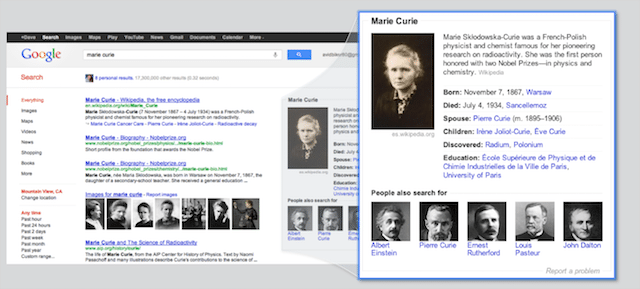
At the time of launch, Google’s Knowledge Graph contained over 500 million objects like people, places, and brands.
Local Snack Pack (2014)
Search engine result pages for queries with local intent were updated to include a 3-pack of local listings.
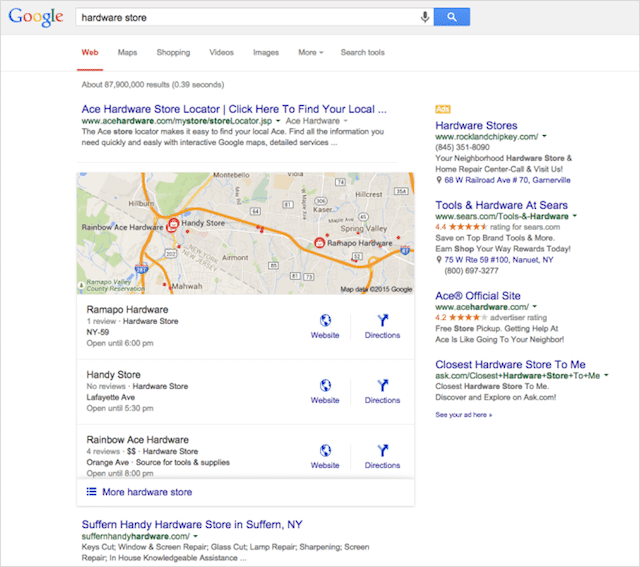
This new “snack pack” included business details such as business name, category, reviews, opening times, website, and directions – features which have remained until today.
Ads Removed from the Right Hand Column (2016)
Ever since Google launched Adwords in the year 2000, text ads had displayed on the right of the search engine results page.
In 2016, Google switched up its SERPs and removed text ads from the right-hand column.
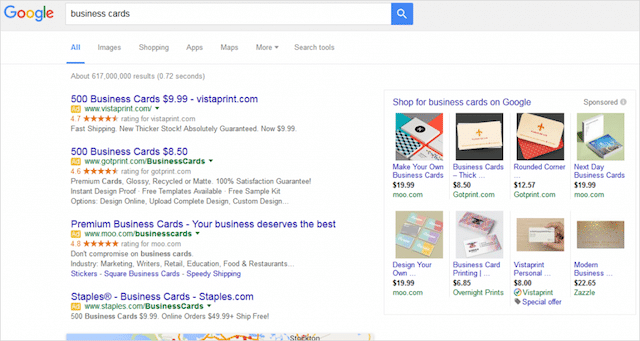
Following this change, up to four ads were visible at the top of the SERP above the organic listings, and as many as three ads were visible at the bottom of the page.
Product listing ads, on the other hand, display still in the right-hand column.
As you can see, the search engine results pages have evolved significantly.
Let’s now discuss how you can rank in the SERPs today.
How to Get Shown in the Search Engine Results Pages (SERPs)
Before you can start winning more traffic and visibility from search engine results pages, you need to (clearly) get into the SERPs.
There are three primary ways you can get shown there:
- Paid results
- Organic results
- SERP features
Let’s breakdown each one down:
(1). Paid Search Results (AKA Google Ads)
Paid search results occupy prime real estate on Google’s first page.
Depending on the query, paid results (also known as sponsored results) get shown at the top and bottom of the page.
For the sake of simplicity, they consist of two ad types:
- Search ads (text based)
- Shopping ads (product listing ads with images)
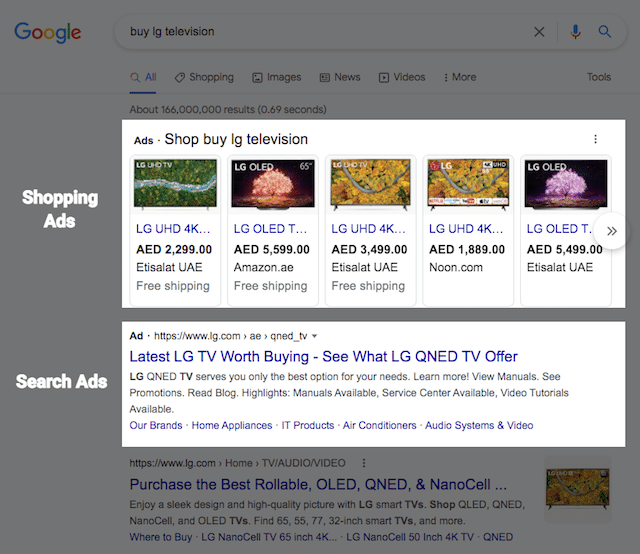
Search ads appear on 35.82% of SERPs and mostly for commercial keywords.
They are hard to tell apart from organic search results.
The only slight difference is that search ads carry a small “Ad” label next to the display URL.

If you want to appear in the paid search results you need “pay to play.”
The paid search ads use a Pay-Per-Click model. Advertisers can bid on certain keywords, and when their ad is shown and clicked on, they pay Google for the click.
The price paid per click can be as little as a dollar to as much twenty dollars or more for competitive keywords. Cost-per-click prices are particularly expensive in the legal, dentistry, and home improvements markets.
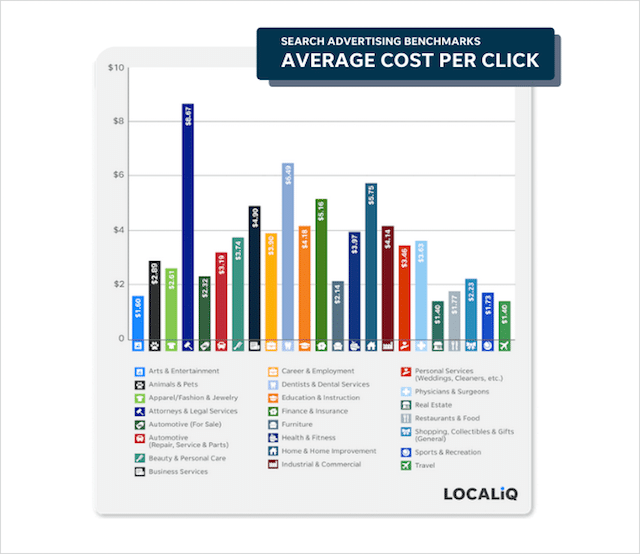
Generally, the very top ad result will combine a high bid, with a relevant ad and good CTR. Google will not show an ad in the top positions if it’s irrelevant to the target keyword.
Pros – Fast results, easy measurement, prime positioning on the first page, can start with a small budget.
Cons – You pay for every click, if you have no budget your ads will stop, it can be very expensive at scale.
(2). How to Rank in the Organic Search Results (SEO)
Organic search results are free listings.
They consist of pages from Google’s indexed, ranked, and ordered according to their relevancy to the query.
The process of ranking the results is done by Google’s complex algorithm, which uses 200+ factors to determine the relevancy and quality of a page for any given keyword.
Google’s algorithm is shrouded in secrecy, but thank’s to various SEO experiments, we have over the years gained a very good understanding of the most important ranking signals.
- Off-page SEO signals such as the number and quality of the websites linking to a specific page.
- On-page SEO signals such as the relevancy and depth of content on the page.
- Page experience signals – such as page speed and other core web vitals.
When displaying a website in the organic search results, Google will usually show a clickable title link, a descriptive snippet, and the URL.

You can influence what Google displays by setting a page’s title tag, URL slug, and meta description.
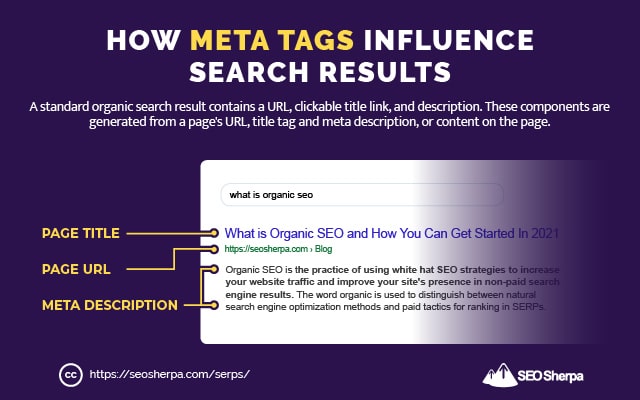
But, keep in mind that setting these meta tags doesn’t guarantee Google will show them.
Google only chooses the hard-coded meta description about x% of the time and often opts to display the H1 header tag instead of the title tag element.
The title link, description, and URL are not the only elements to appear in search snippets.
If Google deems the recency of the page to be important, they may include the publishing date:
Furthermore, if structured data (AKA “Schema”) is implemented on the page, ratings, FAQs, and product information can be displayed in rich snippets.
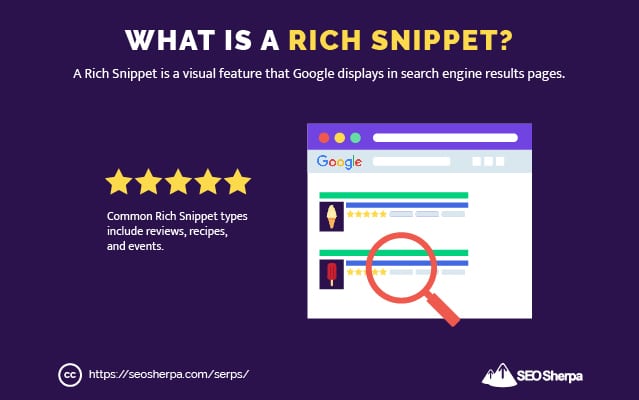
Long story short, in order to rank prominently in organic search results, you need to get your SEO basics in place, generate optimized SEO content that fulfills searchers’ needs, and ensure your pages are well-cited by executing various link building strategies.
So what are the advantages and disadvantages of ranking in organic search results?
Pros – Organic rankings are free, organic results generate the most clicks, rankings can maintain for years.
Cons – It can take months of SEO to rank, listings can get pushed down the page by ads and SERP features.
(3). How to Rank in the SERP Feature’s
SERP features are any type of search result that is not a sponsored, or organic listing.
There are literally dozens of SERP features that appear on Google’s first page from featured snippets, to People also ask, Top stories, and Knowledge Graph results.
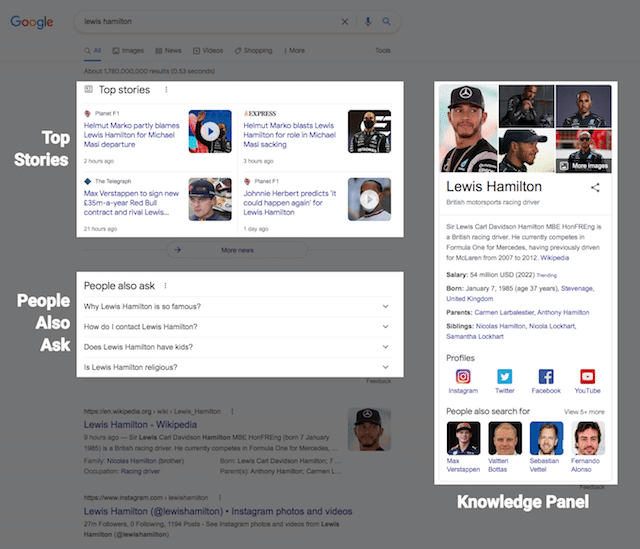
The number of SERP features has increased significantly over the years, resulting in organic listings for some queries getting pushed down way below the fold.
And, because the general purpose of SERP features is to display more information there is less need for users to click-through to websites anyway.
As a result, organic CTR plummeted from 67% in 2015 to 39% just three years later.
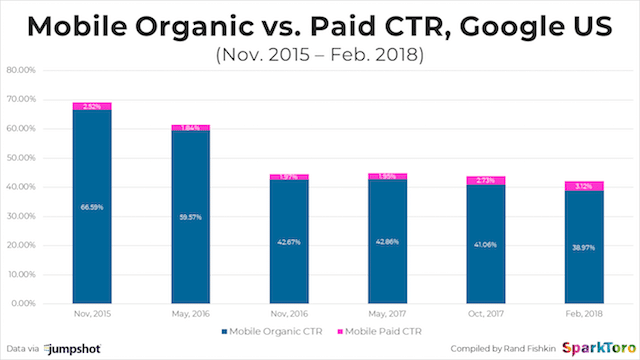
Does that mean you shouldn’t try and rank in the SERP features?
On the contrary.
While overall organic CTR has been negatively affected if you appear as SERP feature your CTR can be crazy.

That’s reason enough to get featured there.
So what SERP features are there?
While not all SERP features include a direct link to your website, they almost always appear prominently on the page:
Here’s a rundown.
SERP Features: A Comprehensive List
Google displays an array of SERP features in its search results these days.
And, they’re frequently testing new ones.
Next, I’ll talk you through the most common features appearing in the SERPs right now, and if and how you can optimize your site to display them there.
- Featured Snippets
- Direct Answer Box
- Knowledge Panel
- Local Pack
- Image Pack
- Video Results
- Top Stories
- People Also Ask
- Twitter Cards
- Site Links
Featured Snippets
As the name suggests, featured snippets feature a snippet of content that’s pulled from a webpage or video.
Featured snippets are designed to answer a query quickly without a user needing to leave the search engine results themselves. Although other listings can appear above them, featured snippets are usually displayed above the number one ranked web result at the very top of the SERP.
This top position is commonly referred to as “position zero.”
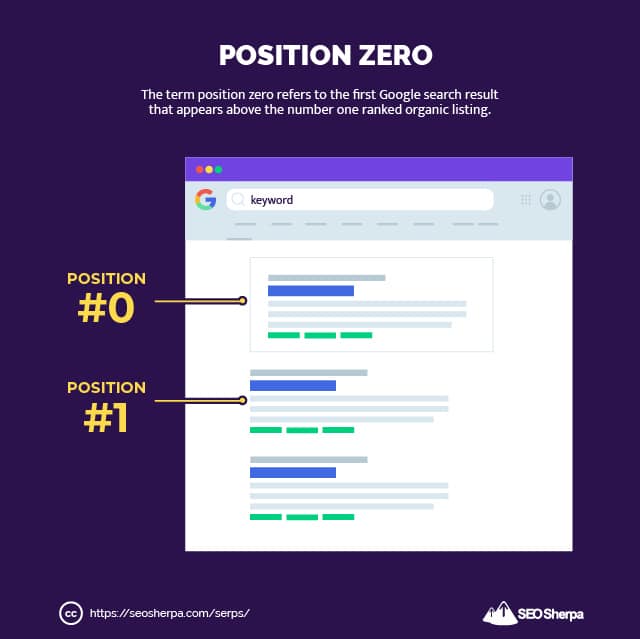
According to a study by Semrush, 19% of all search engine results pages include a featured snippet.
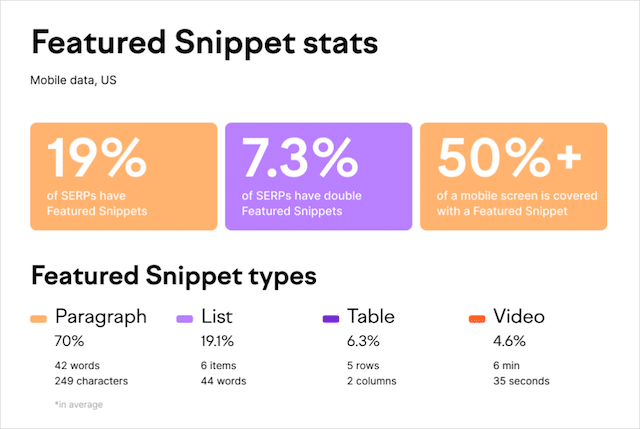
The most common featured snippet types are:
- Paragraph – text designed to give searchers a concise definition or description.
- List – shown for an ordered set of steps or best of lists.
- Table – data pulled from a page and displayed as a table.
Most featured snippets contain text (either as a paragraph, list, or table), but sometimes featured snippets are videos:
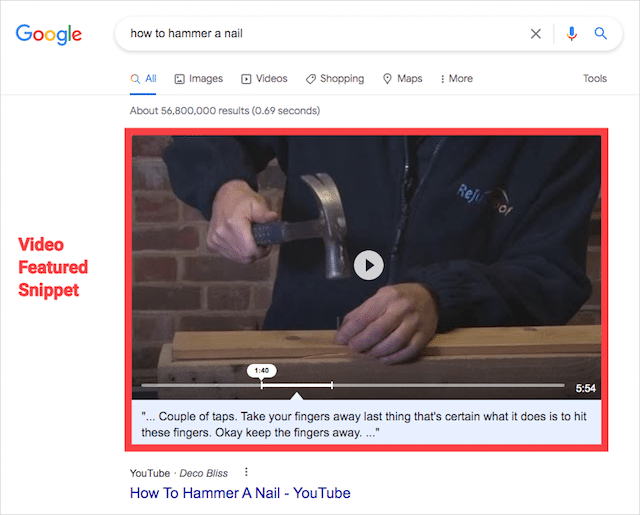
A study by Ahrefs found that 99.58% of featured snippets get pulled from web pages ranking on Google’s first page.
So, if you want to get shown as a featured snippet (and the query you are targeting shows one) you first need to rank in the top-ten web results, then format your content appropriately.
Direct Answer Box
Answer boxes are displayed at the top of the SERP in response to a question-based query.
Direct answer boxes (also known as “knowledge cards” or “instant answers”) provide a short and definitive answer to a given query. There are several different formats.
Here is an example:
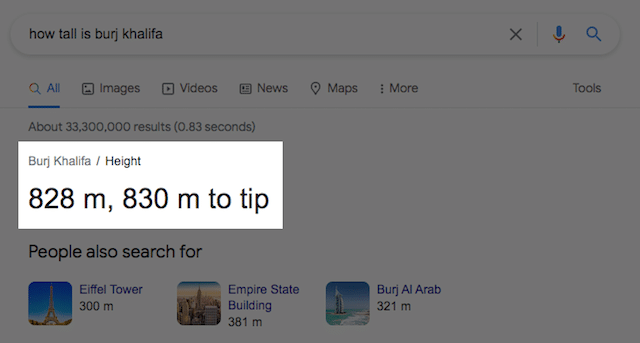
And, here is another answer box specimen:

The answers that Google displays are extracted from public domain information. Common sources are sites like Wikipedia, official government bodies, and reputable data partners.
Unlike Featured Snippets, your website cannot rank there, and neither would you want to since answer boxes don’t link to the answer and rarely credit the source.
Knowledge Panel
The Knowledge Panel is displayed on the right-hand side of the SERPs on desktop, and near the top of the SERPs on mobile.
This SERP feature is shown for queries relating to specific entities including people, places, or things.
A Knowledge Panel includes a bunch of facts that are relevant to the entity.
Here’s the information that’s shown when I search for Queen Elizabeth:
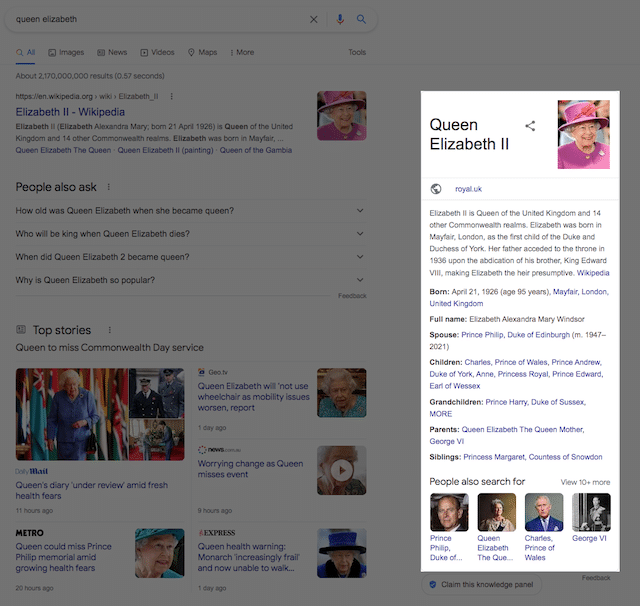
Landmarks, celebrities, cities, sports teams, buildings, companies, geographical features, movies, celestial objects, works of art, and more can all get shown as a Knowledge Panel.
Most of this data is scraped from Google-approved sources like Wikipedia, Wikidata, and Crunchbase.
But for companies that information is extracted from Google My Business.
If you are a location or service-area business then it’s well worthwhile claiming and optimizing your Google Business profile.
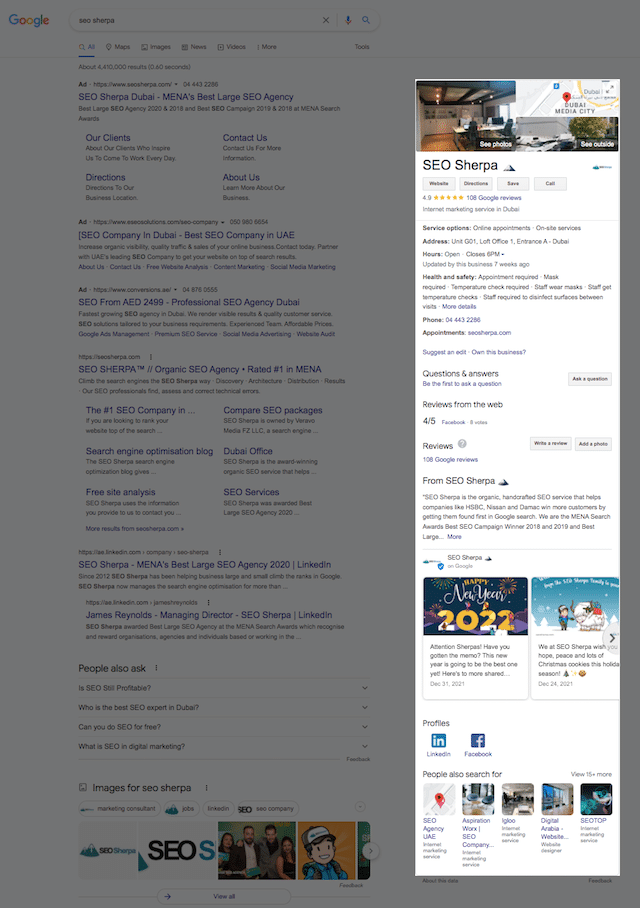
Not only will your business profile get shown when someone searches your business or location.
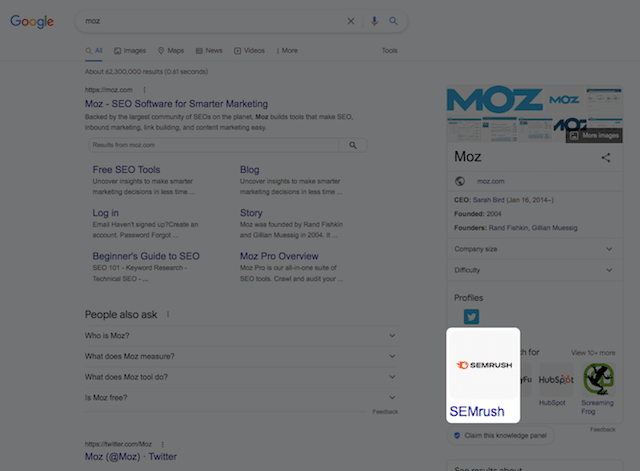
But a logo for your business can also get shown when someone searches for a rival business.
Pretty cool.
Local Pack
Another benefit to claiming and optimizing a Google My Business profile is that you can appear in the local three-pack.
Otherwise known as the “local snack pack” this feature gets shown for queries with local intent, e.g., “SEO agency near me” or “SEO agency Dubai.”
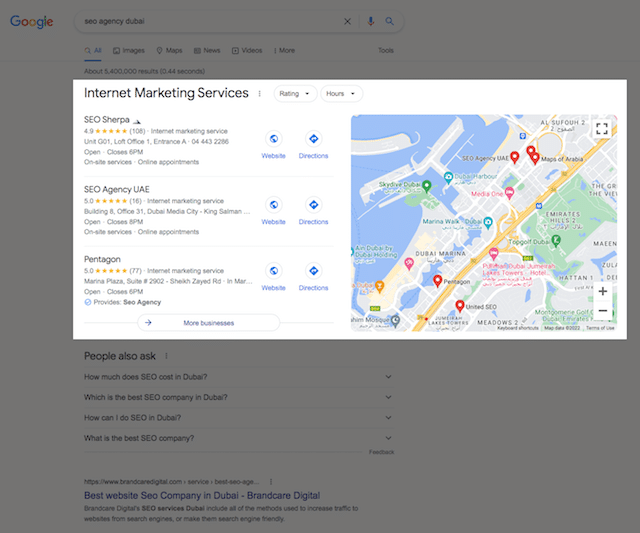
The local pack contains three business results, that include the business’s name, address, telephone, opening hours, reviews, and a link to the business’s website.
Aside from securing a Google My Business profile, to rank consistently in the local pack, you’ll need to employ local SEO techniques like review generation and local link-building strategies.
Image Pack
If you search a keyword requiring a visual answer, Google will return a set of thumbnails from Google Images.
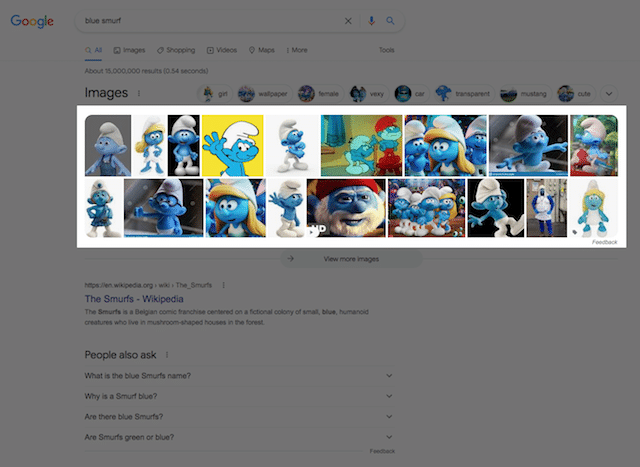
You’ll normally find the image pack at the very top of the page, but it can also be shown further down the SERP.
To get your images ranked in the image pack, you need to improve your image SEO:
- Include your keyword in the file name
- Use a desciptive alt tag containing your target keyword
- Embed the image on a relevant page
But, there’s a downside.
When a user clicks on one of these results they go to Google Images and not your website.
That’s why I include our logo on all the custom images we produce for the blog.
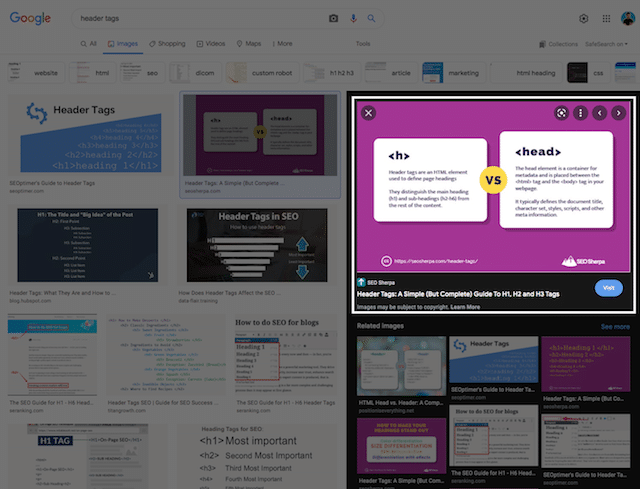
Even if the user doesn’t take the extra step to click from Google images to the SEO Sherpa website, at least I still get some branding benefit.
Video Results
When the search query demands it, Google will display videos in the SERP.
In 88% of cases, video results are pulled from YouTube. This number rises to 91% if the user states “video” in their query.
So, if you want to show up in the video results, it’s clear you’ll need to host your video on YouTube.
Sure, videos can be displayed from other sources, but it’s far less frequent.
Plus, you’ll need to go through the process of adding VideoObject schema markup to your page.
And that’s a bit of a hassle.
Top Stories
Top stories display in a carousel and show recently published articles, live blogs, and videos.
You’ll find the top stories carousel show up for terms related to current news stories.

As you see above; Google shows a thumbnail, title, publisher name, and timestamp for each news story it displays. Top stories are normally shown at the top of the SERP and are returned when a particular news story is trending.
Unfortunately, it’s really hard to get featured in the Top Stories carousel unless you are a Google News-approved website.
In fact, just 0.69% of results on desktops come from sites that are not indexed in Google News.
What’s more:
Ranking in Top Stories tends to be very short-lived. The nature of these results demands fresh content, and in most cases, freshness lasts only a matter of hours.
In other words, unless you are a news outlet, attempting to rank in Top Stories isn’t worth the effort.
People Also Ask
The People Also Ask feature shows questions related to your query, that users often ask on Google.
Google usually inserts the People Also Ask questions midway down the SERP.
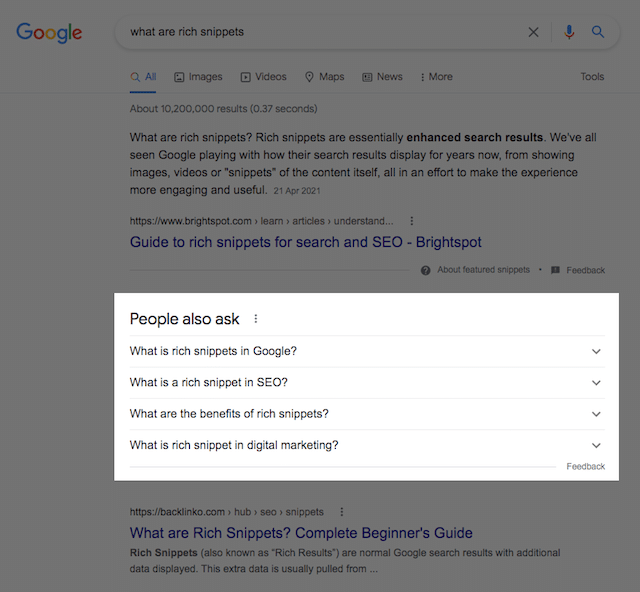
It contains a set of questions – and displays their answers when you click on the down arrow.
The cool thing about People Also Ask is that it offers users an effortless way to find answers to their next query without leaving the SERP.
Basically…
Google is predicting what you might want to know next before you’ve even thought of it.
Pretty cool, right?
According to Ahrefs, 43% of Google’s search results contain a People Also Ask section.
And this can provide an excellent source of topic ideas as part of your content marketing research.
Ranking in People Also Ask is a lot like ranking in instant answer featured snippets.
You need a short succinct answer to each question displayed on your website.
To get ideas for People Also Asked keywords I recommend AlsoAsked.com.
Twitter Cards
Twitter Cards (also known as “Tweet Boxes”) display the most recent Tweets from a specific Twitter account.
For example, a search for Hubspot surfaces a Tweet Box midway down the SERP:

Since Google includes actual tweets in its index, it’s able to display Hubspot’s tweets interactively within the SERP and not just a link to the Hubspot Twitter profile.
You’ll find Twitter cards displayed for branded queries, but they can also find them for relevant non-brand queries too.
Queries relating to trending events such as sports games may show Tweets from multiple accounts.
Site Links
There are two types of site links.
Sitelinks that link to internal pages on the same website:
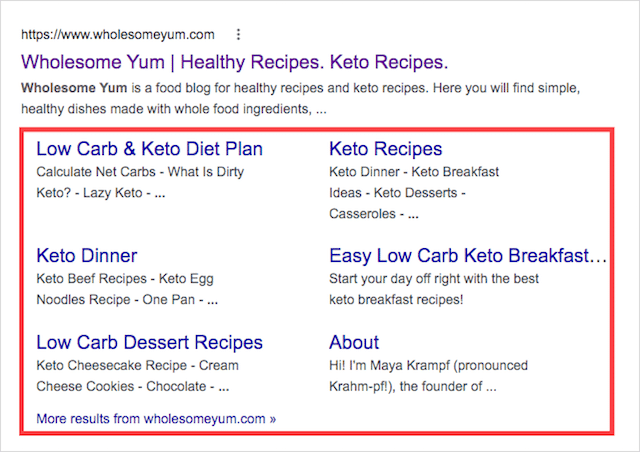
Sitelinks that link to other sections on the same webpage:

Either way, site links are displayed below the main result – and as such, they are more of a SERP enhancement than an actual SERP feature.
Sitelinks should appear naturally for brand queries, and Google will display your site’s most prominent pages, just as they do here for SEO Sherpa:
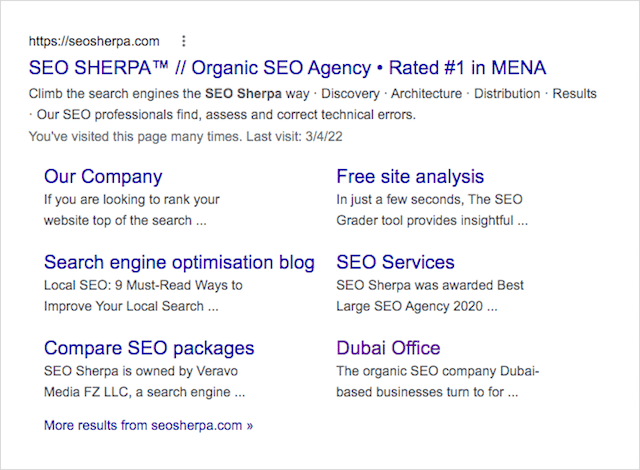
Hint – to dictate which links on your site get shown, ensure your desired pages are linked prominently within your main navigation.
You can also influence the site links for internal links on the same page.
The best way to do that is by adding jump links to important sections of the same page.
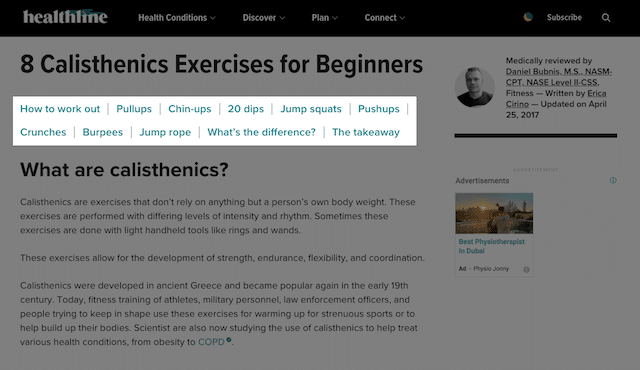
Healthline did this, and it resulted in site links getting shown within the search engine results page.

Pretty cool.
Factors Influencing What Gets Shown in SERPs
Google and other search engines use complex algorithms to determine the make-up of the SERPs.
These factors change over time as their algorithms evolve to better understand what makes a quality result from a user’s point of view.
Let’s take a look at the main facets affecting what gets shown in the search engine results pages today.
(1). Search Intent
Simply put, search intent is the “why” behind the search.
When a user performs a search query they want to accomplish any one of these things:
- Navigate to a website – e.g., “facebook”
- Find information – e.g., “who is will smith”
- Buy something – e.g., “buy iphone x”
- Do some commercial investigation – e.g., “best hotels in Dubai”
In most cases, it’s obvious to search engines what users are looking for.
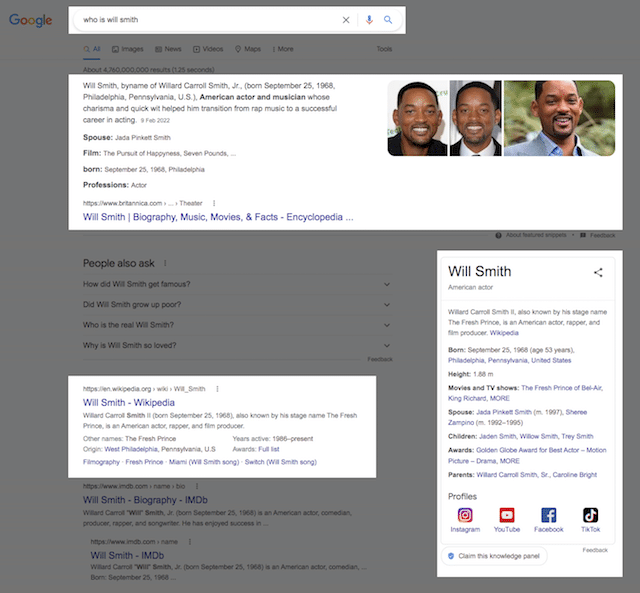
But in other instances, it’s not always as clear.
Take the query “website audit.”
Searchers of this keyword may want to learn how to do a website audit (informational intent) or get an audit done of their website (transactional intent).
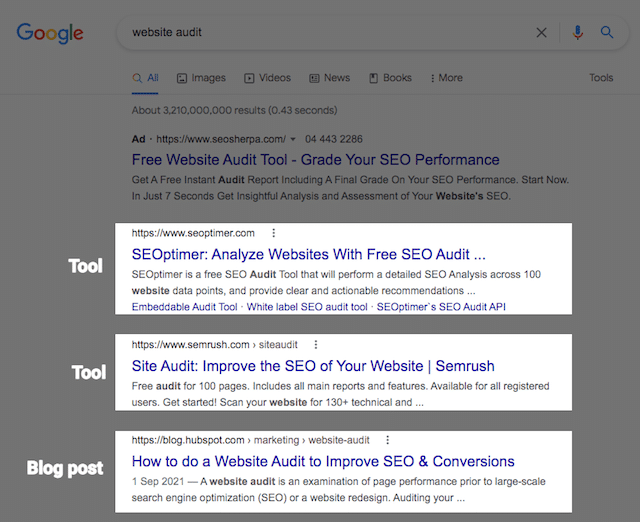
When there is mixed intent, Google will show the best results for each search intent and will display results for the most likely intent towards the top.
(2). Location
Where someone is located when they perform a search influences the results they are shown.
A query for “italian restaurant” searched in Dubai (where I am now):
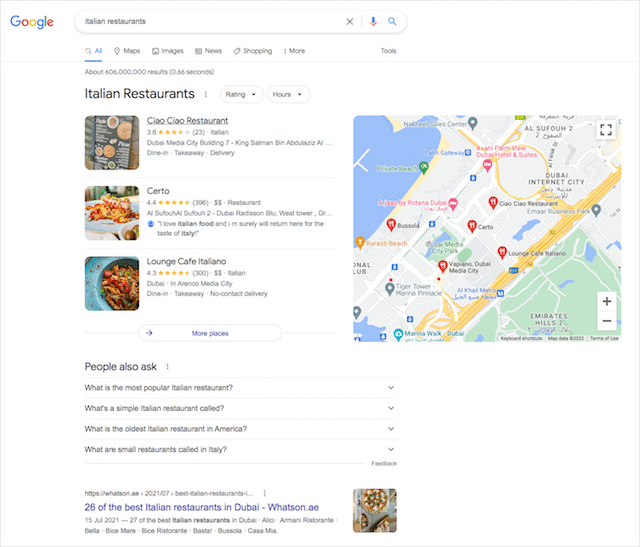
Shows a very different set of results compared to the exact same query searched in New York:
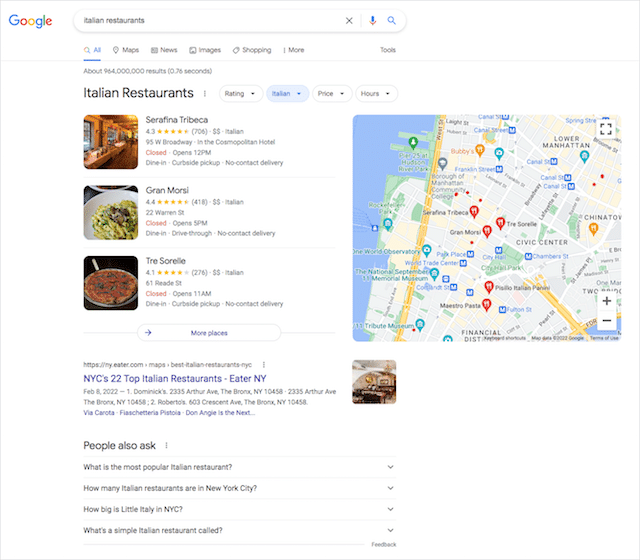
Not only that, but a search from a separate location within the same city can display very different listings.
If a search engine infers a query has local intent, results within close proximity to the searcher will be given preference.
(3). Search and Browser History
Google personalizes search results according to each user’s browsing history.
Here’s how it works:
Let’s say you visit Booking.com more frequently than you do Agoda, Google will deduce that you are more interested in Booking.com’s results and will personalize the SERP to show Booking.com higher for relevant searches.
Google does this by analyzing web cookies saved in your browser – and by viewing your complete web history if you are logged into Google.
The type of data Google uses, includes:
- Searches you’ve done on Google
- Search results you’ve clicked on
- Websites you’ve visited
- Videos you’ve watched
- Store locations you’ve visited
If you’d like to see search results that are not personalized, you should search in incognito mode.
(4). On-Page SEO
How well the content on a page answers the search query is perhaps THE most important factor affecting what results are shown in the SERP.
For a page to be considered for ranking it should contain content that satisfactorily answers the target search query.
Google crawls several on-page elements to determine a page’s relevancy:
- Title tag
- Headings (H1, H2, H3, etc)
- URL
- Body content
- Images
To increase your own chances of ranking high in the SERPs it’s recommended to include your target keywords in these places on your page.

To rank higher than all competing pages, your content should answer the search query better than anyone else’s.
Generally speaking – the results that best answer a user’s search query will be placed at the very top of the SERP. At least that’s Google’s goal.
(5). Off-Page SEO
Search engines don’t only rely on the content on a page to determine its relevancy.
They also evaluate various off-page signals. Things like:
- Number of brand mentions
- Volume of links to the page
- Authority of links to the page
- Anchor text used in the links
And so on, and so forth.
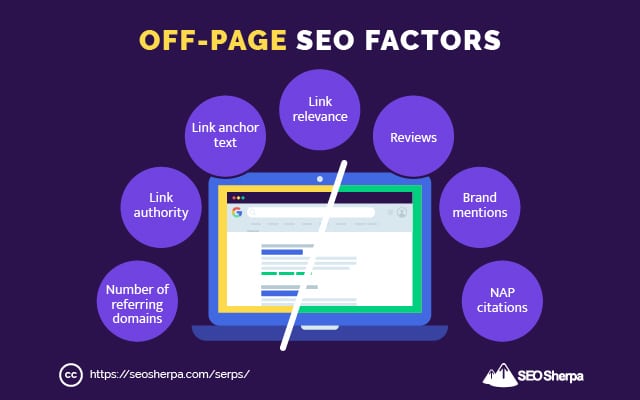
By evaluating these off-page factors Google is able to gauge a page’s authority by the number and relevancy of pages citing it as a source.
Of all off-page signals, link metrics have by far the highest influence over results in the SERPs.
Final Thoughts
The more you know about SERPs and SERP features, the easier it will be for you to leverage search engine optimization to win more visibility for your business on Google.
But simply staying up to date with Google’s trends isn’t enough.
You need to know and apply SEO strategies that improve your site’s search engine optimization – and allow you to climb towards Google’s first page.
To help you get started, I’ve put together a step-by-step checklist that will show you how to quickly and easily implement nine SEO fundamentals.
Best of all, you can download the PDF checklist for free, below:

